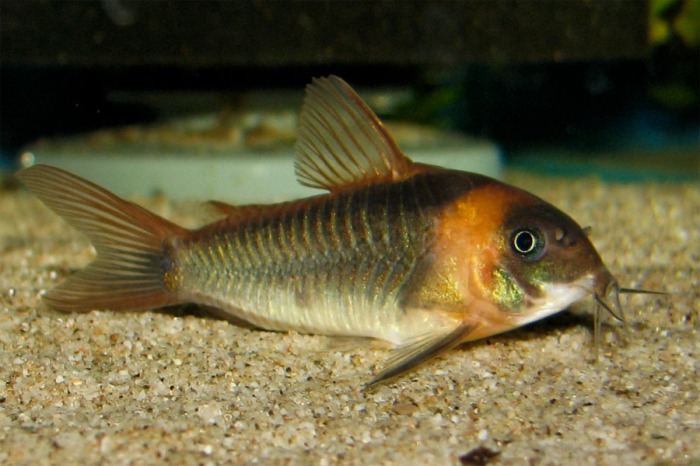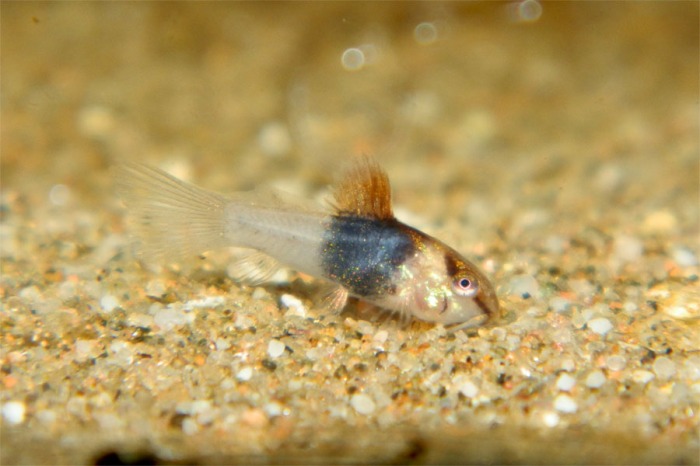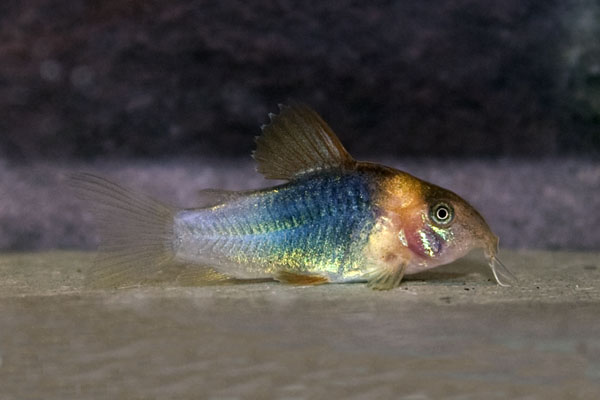Introduction

Corydoras eques is one of the many small, armoured catfish from South America that are so popular in the hobby. An attractive little fish, its relative scarcity means that it costs rather more than its more common cousins. First described (as Osteogaster eques) as long ago as 1876 by the Austrian zoologist Franz Steindachner it has only intermittently appeared on importers lists.
Distribution and Availability
The horseman’s corydoras is found in the Rio Amazonas at Codajas, Brazil. Specimens of this, or perhaps another very similar fish have also been collected in Peru.
Available only from specialist shops or from fish breeders who have been lucky enough to spawn this species. Many shops advertise Corydoras eques but in most cases these turn out to be nicely marked variants of Corydoras aeneus.
Description
A medium-sized corydoras with a short snout. Base colour is dark blue-grey with a large orange band behind the eyes running between the base of the fishes pectoral fins and over the head. There is a chestnut stripe down the centre of the fishes back and a metallic green sheen over the dark parts. The darkness can vary depending on the colour of the substrate and often a broad stripe can be seen running down the sides similar to that of its close relative Corydoras rabauti. This stripe is darkest just below the dorsal spine and can appear as a dark patch at that point. The chin and throat are pearly white. All the fins are dark grey to orange. A stunningly beautiful little catfish that, once seen, can never be mistaken for any other species.

Male – up to 4.5cm.
Female – up to 5cm. Deeper bodied and larger than male as is the case with most of the genus.
Requirements
An easy fish to care for and can be safely kept in a community tank with other peaceful fishes. Keep in a shoal of at least 6 specimens, preferably more.
- Tank size: 90cm minimum.
- Decoration: Sand substrate with some hiding places such as clay pipes. Fine leaved plants are used for spawning.
- Temperature: 22 – 26oC
- pH: 6.0 – 8.0
- Hardness: 2 – 16 dH
Feeding
Easy to feed and accepts all types of sinking tablets and flakes. Supplement with frozen and live foods such as newly hatched brine shrimp and daphnia. Feed white worms and Grindal worms as occasional treats.
Breeding
These fish have proven to be rather difficult to breed but it can be done. Place a conditioned pair or two in a smallish tank with a sponge filter and lots of fine-leaved plants. Include floating plants as the fish like to lay their eggs near the surface. A period of stability of several weeks can be followed by a large water change with cooler water. If you are lucky, the fish will spawn in the usual corydoras manner laying several hundred eggs in the process.

- Corydoras eques – 1 week old
The eggs remain unmolested by the parents and can be left in place or removed to a container for hatching artificially. If the eggs are left with the parents, provide a small pile of broken crockery or similar for the fry to hide in.

The fry hatch in 5 days or so and will be free-swimming a couple of days after that. Do not feed them until this time. The attractive pattern, which the fry share with Corydoras rabauti can be seen from 10 days or so. Development is normal for the genus and the fry should be fed on microworm, pre-soaked finely crushed flake and newly hatched brine shrimp. They grow quickly and start to develop the adult pattern from about 5 or 6 weeks of age.

They are large enough to move on by the time they are 3 months old and the successful breeder will have no problems finding new homes for the youngsters.

Summary
Corydoras eques is a beautiful and easy to keep catfish. A large shoal makes an impressive addition to a big show tank whilst breeding the species will provide a challenge to even the most experienced Corydoras enthusiast.
References
- Planet Catfish – species summary
- Fishbase – species summary
thanks for the imformation,shall be putting it into practice as soon as
LikeLike
thanks Graham will get round to trying them one day
John
LikeLike